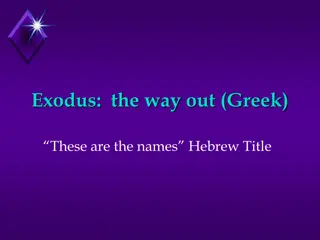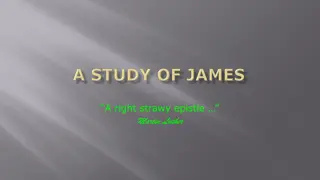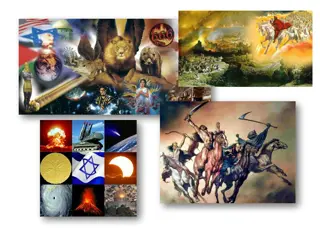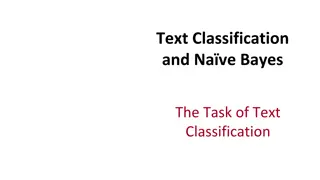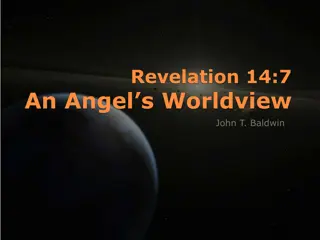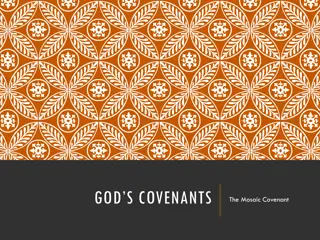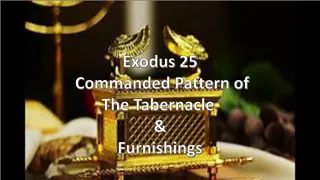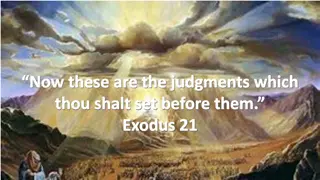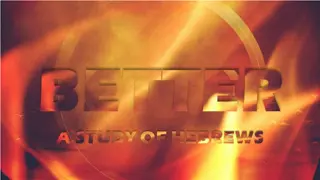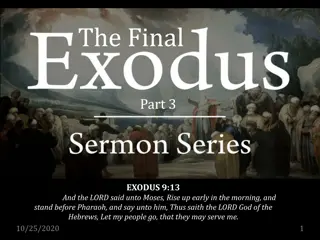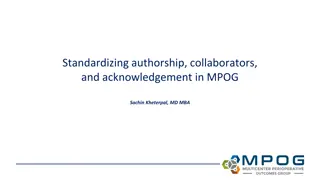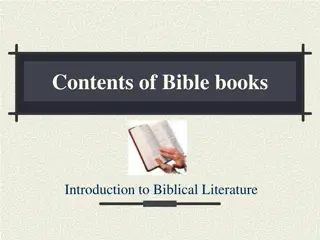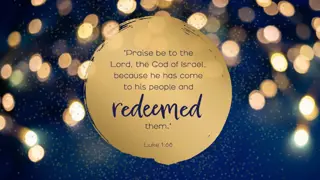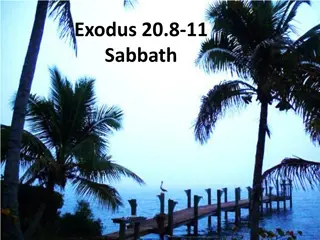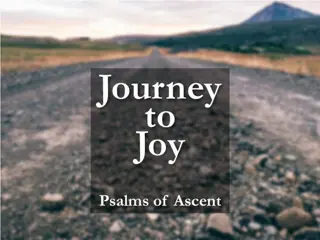Understanding the Authorship and Overview of Exodus According to the Bible
The authorship of Exodus is attributed to Moses according to the Bible. It narrates the miraculous deliverance of God's people from Egypt, the establishment of the covenant at Sinai, and the giving of the law as a charter for Israel. The book outlines Israel's time in Egypt, the journey from Egypt to Sinai, the covenant and law at Sinai, and the purpose of the deliverance pre and post. The Exodus events are dated back to the reigns of Pharaohs Thutmose III and Amenophis II.
Download Presentation

Please find below an Image/Link to download the presentation.
The content on the website is provided AS IS for your information and personal use only. It may not be sold, licensed, or shared on other websites without obtaining consent from the author. Download presentation by click this link. If you encounter any issues during the download, it is possible that the publisher has removed the file from their server.
E N D
Presentation Transcript
Exodus/Leviticus Authorship according to the Bible Moses (by inspiration 2 Pt 1:20-21) - Num 33:2 Moses wrote - Law of Moses (Judges 3:4; John 8:5) - Jesus (Mark 12:26; Luke 22:44) - New Testament (Acts 7:44; Heb 7:14)
Exodus Miraculous deliverance of God s people from bondage in Egypt, covenant relationship expanded to Israel as His people at Sinai, and the law given as a theocratic charter for Israel.
Exodus Time: - The book opens with the events around the birth of Moses. - The book ends with the dedication of the tabernacle in the first month of the second year after leaving Egypt. - About 85 years.
Exodus Date: - Thutmose III (1504-1450) is the pharaoh of the oppression. - Amenophis II (1450-25) is the pharaoh of the Exodus. - Places the writing in 1446-1437 BC
Exodus Outline: I. Israel in Egypt A. Slavery in Egypt (1) B. Birth and early life of Moses (2-4) C. Pharaoh s oppression of Israel (5:1- 6:13) D. Genealogies (6:14-27) E. The plagues and Passover 6:28-12:36)
Exodus Outline: II. The journey from Egypt to Sinai A. The Exodus from Egypt (12:37-14:31) B. The song of Moses (15:1-21) C. The wilderness of Shur (15:22-27) D. The wilderness of Sin (16) E. The rock at Rephidim (17) F. Jethro and Moses (18)
Exodus Outline: III. Covenant and law at Sinai A. Preparations for the covenant (19) B. The ten commandments (20:1-17) C. The covenant code (20:18-23:33) D. Ratification of the covenant (24) E. The tabernacle (25-40) 1. Specifications (25-27) 2. The priests (28-29) 3. The furniture (30)
Exodus Outline: 4. 5. 6. 7. 8. 9. 10. 11. The craftsmen (31:1-11) The Sabbath (31:12-18) The golden calf (32) God and Moses (33) Covenant renewal (34) Construction of the tabernacle (35-38) The priestly garments (39) Completion and dedication of the tabernacle (40)
Exodus Purpose: Pre-deliverance (6:2-9) Post-deliverance (19:1-6)
Exodus Major themes: I AM : (3:14) the self revelation of God to man. (John 8:58) The Passover: (12) Memorial feast (John 1:29) The ten commandments: (12:1-17) The presence of God: (25:8) (John 1:14)
Leviticus Expansion of covenant law for the purpose of holiness among the people of God, since He will dwell in their midst.
Leviticus Name: Hebrew Vayikra (He [God] Called) English Derived from the Greek title Leuitikon in the Septuagint meaning pertaining to the priests
Leviticus Chronology: It was written from the tent of the meeting (1:1; EX 33:7-9) Written after Exodus.
Leviticus Cultural: Many cultures had a priestly system, sacrifices and offerings. Ex 19:5 Different: - Direct divine revelation - Strict monotheism - Human sin - Moral and ethical law - No human sacrifice
Leviticus Outline: I. A. Approaching a holy God Laws about sacrifice (1-7) 1. Burnt offering (1:1-17) 2. Grain offering (2) 3. Peace offering (3) 4. Sin offering (4:1-5:13) 5. Guilt offering (5:14-6:7) 6. Instructions for priests (6:8-7:38) Laws about the consecration of priests (8-10) 1. Anointing of Aaron and his sons (8) 2. Aaron s sacrifice (9) 3. Death of Nadab and Abihu (10) B.
Leviticus Outline: II. A. Living in the presence of a holy God Laws about clean and unclean things (11-15) 1. Food (11) 2. Child birth (12) 3. Leprosy and skin diseases (13-14) 4. Discharges and secretions (15) Laws about holiness (16-25) 1. The day of Atonement (16) 2. Taboo on eating and drinking food (17) 3. Laws about sexuality (18) 4. Civil and ceremonial laws (19) 5. Various laws and punishments (20) 6. Laws for priest (21-22) 7. Feasts and calendar (23-25) B.
Leviticus Outline: III. Covenant blessings and curses (26) IV. Laws about vows and gifts (27)
Leviticus Purpose: For I am the LORD your God. Consecrate yourselves therefore, and be holy, for I am holy For I am the LORD who brought you up from the land of Egypt to be your God; thus you shall be holy, for I am holy. (Lev 11:44-45) 1-10: Requirements for worshipping God 11-27: How to be holy on a daily basis and you shall be to Me a kingdom of priests and a holy nation (Ex 19:6a) But you are a chosen race, a royal priesthood, a holy nation, a people for God's own possession, so that you may proclaim the excellencies of Him who has called you out of darkness into His marvelous light; for you once were not a people, but now you are the people of God; you had not received mercy, but now you have received mercy.(1Pe 2:9-10)
Leviticus Major themes: Holiness 26:1-13 the reward of holiness Sacrifice For the life of the flesh is in the blood, and I have given it to you on the altar to make atonement for your souls; for it is the blood by reason of the life that makes atonement. (Lev 17:11) And according to the Law, one may almost say, all things are cleansed with blood, and without shedding of blood there is no forgiveness. (Heb 9:22)


